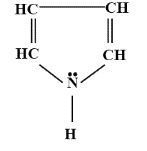
How many delocalised

A. 1
B. 2
C. 4
D. 6

Answer
516.6k+ views
Hint: A pair of electrons which do not make any bond are known as lone pairs whereas a pair of electrons, which is found in the paired condition they are known as electron pairs. Lone pairs electrons can move in the lattice structure.
Complete step by step answer:
- The delocalised electrons are those electrons which can move from one bond to the other in a molecule structure.
- The structure which is given in the question is of pyrroles, a 5-membered ring.
- In the given, we have to tell about the delocalised electron but they should belong to
-
- So, as we can see that there are a total of two double bonds so there are 4
- Along with it, two delocalised
- So, a total of 6 delocalised
- These delocalised electrons are also responsible for the electrical conduction due to their movement in the lattice structure.
Therefore, option D. is the correct answer.
Note:
Complete step by step answer:
- The delocalised electrons are those electrons which can move from one bond to the other in a molecule structure.
- The structure which is given in the question is of pyrroles, a 5-membered ring.
- In the given, we have to tell about the delocalised electron but they should belong to
-
- So, as we can see that there are a total of two double bonds so there are 4
- Along with it, two delocalised
- So, a total of 6 delocalised
- These delocalised electrons are also responsible for the electrical conduction due to their movement in the lattice structure.
Therefore, option D. is the correct answer.
Note:
Latest Vedantu courses for you
Grade 11 Science PCM | CBSE | SCHOOL | English
CBSE (2025-26)
School Full course for CBSE students
₹41,848 per year
Recently Updated Pages
Master Class 11 Business Studies: Engaging Questions & Answers for Success

Master Class 11 Economics: Engaging Questions & Answers for Success

Master Class 11 Accountancy: Engaging Questions & Answers for Success

Master Class 11 Computer Science: Engaging Questions & Answers for Success

Master Class 11 English: Engaging Questions & Answers for Success

Master Class 11 Maths: Engaging Questions & Answers for Success

Trending doubts
The flightless birds Rhea Kiwi and Emu respectively class 11 biology CBSE

1 litre is equivalent to A 1000mL B 100cm3 C 10mL D class 11 physics CBSE

A car travels 100 km at a speed of 60 kmh and returns class 11 physics CBSE

Name the Largest and the Smallest Cell in the Human Body ?

Explain zero factorial class 11 maths CBSE

In tea plantations and hedge making gardeners trim class 11 biology CBSE




